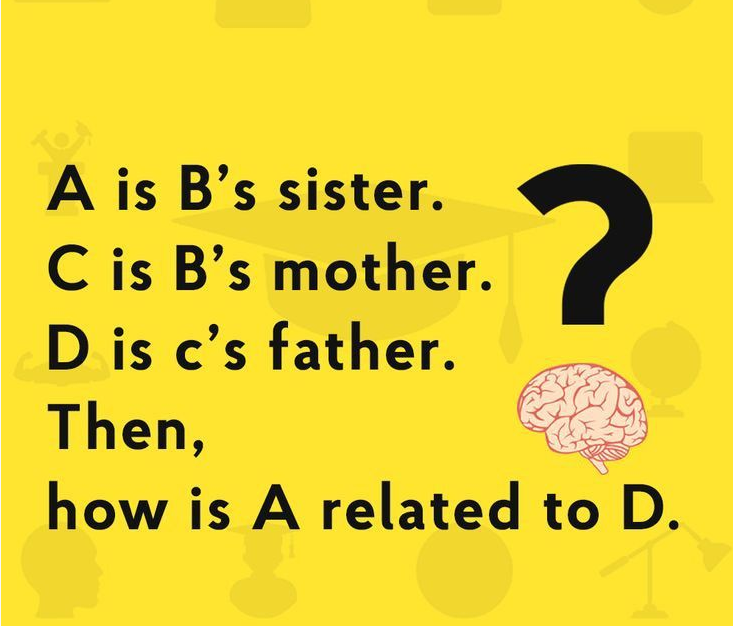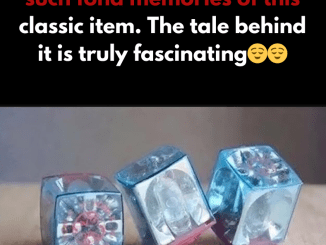Riddles are a brilliant way to challenge our minds, sharpen our reasoning skills, and have a little fun while we’re at it. One of the most engaging categories of riddles is the family relationship puzzle—simple in appearance but often hiding a twist that catches even the most logical thinkers off guard.
Let’s dive into the riddle you see in the image above. It reads:
A is B’s sister.
C is B’s mother.
D is C’s father.
Then, how is A related to D?
Seems straightforward, right? Don’t be too quick to answer—many people miss the correct connection because of how the relationships are layered.

Why This Puzzle Trips People Up
Before we walk through the logic, let’s address why riddles like this are so tricky.
- The order matters – Many people process the information line by line without looking at the big picture. They think in fragments instead of mapping out the family tree.
- Assumptions get in the way – Our minds naturally assign genders and relationships without fully analyzing the structure. You might quickly guess “father,” “daughter,” or “grandchild” without checking the logic.
- Information overload – With multiple characters and connections, people often confuse who is related to whom, especially if they don’t organize it visually or mentally.
Now let’s break it down carefully, step by step.
Step-by-Step Breakdown of the Puzzle
Let’s make sense of each relationship to find how A is related to D.
Step 1: A is B’s sister.
That means A and B are siblings. So they share the same parents.
Step 2: C is B’s mother.
Since A and B are siblings, C is also A’s mother.
Step 3: D is C’s father.
So D is the father of C. And if C is A’s mother, then D is A’s grandfather.
The Correct Answer: A is D’s Granddaughter
Let’s put it together:
D is the father of C → C is the mother of A →
Therefore, A is D’s granddaughter.
This is one of those puzzles where every line gives you a piece of the family tree. You just need to build it backward to make the right connections.
Video : 10 April 2025
Common Wrong Answers (and Why They’re Wrong)
- Daughter – Many people jump to this conclusion, assuming A is directly D’s child. But remember, D is C’s father, not A’s.
- Niece – This comes up because people confuse the generational gap. But D is not B’s uncle or sibling; he’s higher up the family tree.
- Grandmother – Occasionally, readers get turned around and assume C is A’s daughter instead of mother, flipping the logic completely.
These mistakes all come from rushing through the logic or not keeping track of the family roles carefully.
How to Solve Relationship Riddles More Effectively
Want to get better at puzzles like this? Here are a few simple tips to improve your deduction skills:
1. Visualize It or Draw a Family Tree
Mapping it out visually often makes the connections clearer. Even a simple sketch with arrows can help you see the relationships faster.
2. Work From the Known Information First
Start with what you know (e.g., sibling relationships), and build outward logically. Never assume beyond what the riddle provides.
3. Look for Generational Clues
Words like “father,” “mother,” “daughter,” and “grandfather” give you a sense of who is older or younger. That makes it easier to trace connections.
4. Don’t Rush
Take time to read each line carefully. Riddles are designed to trick you into rushing and making mistakes.
Why Logic Riddles Are Good for the Brain
Solving puzzles like this isn’t just a fun way to pass the time—it actually boosts your brain health. Studies show that logic puzzles:
- Improve memory and concentration
- Strengthen critical thinking
- Train your mind to think outside the box
- Enhance your ability to spot patterns
Video : The Riddle That Will Stump You!
So every time you challenge yourself with a riddle like this one, you’re giving your brain a healthy workout.
Try It With Friends and Family
These types of puzzles are perfect to share with others. Ask your friends: “How is A related to D?” and see how many get it right. You might be surprised at how many people get tripped up—even the clever ones!
It’s also a great activity for kids, helping them practice reading comprehension, logical sequencing, and family role identification in a fun, engaging way.
Conclusion: Don’t Let Simple Words Fool You
This riddle proves one thing: the answer is always in the details. While it may look like a basic family tree puzzle, only those who take the time to trace the logic correctly will land on the right answer.
So next time you’re faced with a logic riddle, slow down, connect the dots, and you’ll probably beat the trick behind it.


